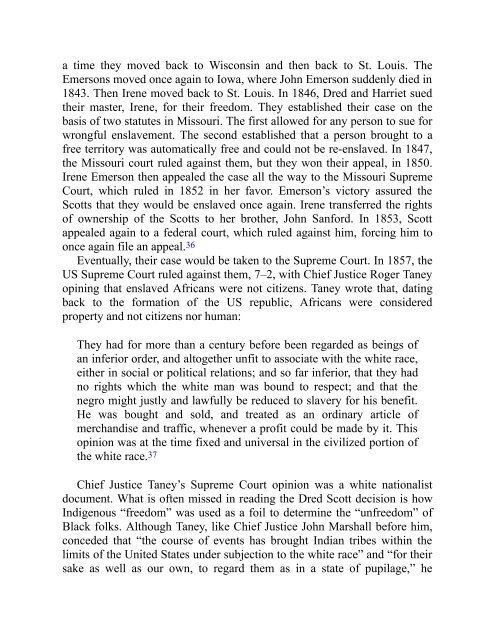You also want an ePaper? Increase the reach of your titles
YUMPU automatically turns print PDFs into web optimized ePapers that Google loves.
a time <strong>the</strong>y moved back to Wisconsin and <strong>the</strong>n back to St. Louis. The<br />
Emersons moved once again to Iowa, where John Emerson suddenly died in<br />
1843. Then Irene moved back to St. Louis. In 1846, Dred and Harriet sued<br />
<strong>the</strong>ir master, Irene, for <strong>the</strong>ir freedom. They established <strong>the</strong>ir case on <strong>the</strong><br />
basis <strong>of</strong> two statutes in Missouri. The first allowed for any person to sue for<br />
wrongful enslavement. The second established that a person brought to a<br />
free territory was automatically free and could not be re-enslaved. In 1847,<br />
<strong>the</strong> Missouri court ruled against <strong>the</strong>m, but <strong>the</strong>y won <strong>the</strong>ir appeal, in 1850.<br />
Irene Emerson <strong>the</strong>n appealed <strong>the</strong> case all <strong>the</strong> way to <strong>the</strong> Missouri Supreme<br />
Court, which ruled in 1852 in her favor. Emerson’s victory assured <strong>the</strong><br />
Scotts that <strong>the</strong>y would be enslaved once again. Irene transferred <strong>the</strong> rights<br />
<strong>of</strong> ownership <strong>of</strong> <strong>the</strong> Scotts to her bro<strong>the</strong>r, John Sanford. In 1853, Scott<br />
appealed again to a federal court, which ruled against him, forcing him to<br />
once again file an appeal. 36<br />
Eventually, <strong>the</strong>ir case would be taken to <strong>the</strong> Supreme Court. In 1857, <strong>the</strong><br />
US Supreme Court ruled against <strong>the</strong>m, 7–2, with Chief Justice Roger Taney<br />
opining that enslaved Africans were not citizens. Taney wrote that, dating<br />
back to <strong>the</strong> formation <strong>of</strong> <strong>the</strong> US republic, Africans were considered<br />
property and not citizens nor human:<br />
They had for more than a century before been regarded as beings <strong>of</strong><br />
an inferior order, and altoge<strong>the</strong>r unfit to associate with <strong>the</strong> white race,<br />
ei<strong>the</strong>r in social or political relations; and so far inferior, that <strong>the</strong>y had<br />
no rights which <strong>the</strong> white man was bound to respect; and that <strong>the</strong><br />
negro might justly and lawfully be reduced to slavery for his benefit.<br />
He was bought and sold, and treated as an ordinary article <strong>of</strong><br />
merchandise and traffic, whenever a pr<strong>of</strong>it could be made by it. This<br />
opinion was at <strong>the</strong> time fixed and universal in <strong>the</strong> civilized portion <strong>of</strong><br />
<strong>the</strong> white race. 37<br />
Chief Justice Taney’s Supreme Court opinion was a white nationalist<br />
document. What is <strong>of</strong>ten missed in reading <strong>the</strong> Dred Scott decision is how<br />
<strong>Indigenous</strong> “freedom” was used as a foil to determine <strong>the</strong> “unfreedom” <strong>of</strong><br />
Black folks. Although Taney, like Chief Justice John Marshall before him,<br />
conceded that “<strong>the</strong> course <strong>of</strong> events has brought Indian tribes within <strong>the</strong><br />
limits <strong>of</strong> <strong>the</strong> <strong>United</strong> <strong>States</strong> under subjection to <strong>the</strong> white race” and “for <strong>the</strong>ir<br />
sake as well as our own, to regard <strong>the</strong>m as in a state <strong>of</strong> pupilage,” he


















